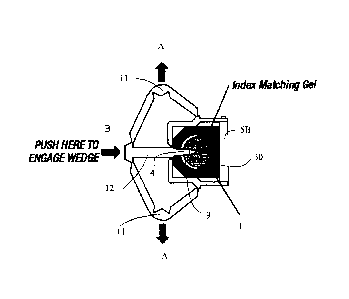Une partie des informations de ce site Web a été fournie par des sources externes. Le gouvernement du Canada n'assume aucune responsabilité concernant la précision, l'actualité ou la fiabilité des informations fournies par les sources externes. Les utilisateurs qui désirent employer cette information devraient consulter directement la source des informations. Le contenu fourni par les sources externes n'est pas assujetti aux exigences sur les langues officielles, la protection des renseignements personnels et l'accessibilité.
L'apparition de différences dans le texte et l'image des Revendications et de l'Abrégé dépend du moment auquel le document est publié. Les textes des Revendications et de l'Abrégé sont affichés :
| (12) Brevet: | (11) CA 2690728 |
|---|---|
| (54) Titre français: | EPISSURE MECANIQUE |
| (54) Titre anglais: | MECHANICAL SPLICE |
| Statut: | Accordé et délivré |
| (51) Classification internationale des brevets (CIB): |
|
|---|---|
| (72) Inventeurs : |
|
| (73) Titulaires : |
|
| (71) Demandeurs : |
|
| (74) Agent: | SMART & BIGGAR LP |
| (74) Co-agent: | |
| (45) Délivré: | 2018-01-02 |
| (86) Date de dépôt PCT: | 2008-10-06 |
| (87) Mise à la disponibilité du public: | 2009-04-09 |
| Requête d'examen: | 2013-09-27 |
| Licence disponible: | S.O. |
| Cédé au domaine public: | S.O. |
| (25) Langue des documents déposés: | Anglais |
| Traité de coopération en matière de brevets (PCT): | Oui |
|---|---|
| (86) Numéro de la demande PCT: | PCT/US2008/078898 |
| (87) Numéro de publication internationale PCT: | WO 2009046402 |
| (85) Entrée nationale: | 2009-12-11 |
| (30) Données de priorité de la demande: | ||||||
|---|---|---|---|---|---|---|
|
La présente invention concerne un appareil d'épissure mécanique qui comprend une épissure mécanique dotée d'une rainure et d'un composant d'alignement avec un coin. Lorsque le coin est mis en prise dans la rainure de l'épissure mécanique, une ouverture est formée dans l'épissure mécanique et lorsque le coin est retiré de la rainure, l'ouverture se ferme.
A mechanical splice apparatus including a mechanical splice with a groove and
an aligning component with a wedge.
When the wedge is engaged in the groove of the mechanical splice an opening is
formed in the mechanical splice and when the wedge
is disengaged from the groove, the opening closes.
Note : Les revendications sont présentées dans la langue officielle dans laquelle elles ont été soumises.
Note : Les descriptions sont présentées dans la langue officielle dans laquelle elles ont été soumises.

2024-08-01 : Dans le cadre de la transition vers les Brevets de nouvelle génération (BNG), la base de données sur les brevets canadiens (BDBC) contient désormais un Historique d'événement plus détaillé, qui reproduit le Journal des événements de notre nouvelle solution interne.
Veuillez noter que les événements débutant par « Inactive : » se réfèrent à des événements qui ne sont plus utilisés dans notre nouvelle solution interne.
Pour une meilleure compréhension de l'état de la demande ou brevet qui figure sur cette page, la rubrique Mise en garde , et les descriptions de Brevet , Historique d'événement , Taxes périodiques et Historique des paiements devraient être consultées.
| Description | Date |
|---|---|
| Paiement d'une taxe pour le maintien en état jugé conforme | 2024-09-27 |
| Requête visant le maintien en état reçue | 2024-09-27 |
| Représentant commun nommé | 2019-10-30 |
| Représentant commun nommé | 2019-10-30 |
| Requête pour le changement d'adresse ou de mode de correspondance reçue | 2018-01-12 |
| Accordé par délivrance | 2018-01-02 |
| Inactive : Page couverture publiée | 2018-01-01 |
| Inactive : Taxe finale reçue | 2017-11-14 |
| Préoctroi | 2017-11-14 |
| Lettre envoyée | 2017-06-01 |
| Un avis d'acceptation est envoyé | 2017-06-01 |
| Un avis d'acceptation est envoyé | 2017-06-01 |
| Inactive : Approuvée aux fins d'acceptation (AFA) | 2017-05-24 |
| Inactive : Q2 réussi | 2017-05-24 |
| Modification reçue - modification volontaire | 2016-12-01 |
| Inactive : Dem. de l'examinateur par.30(2) Règles | 2016-06-01 |
| Inactive : Rapport - Aucun CQ | 2016-06-01 |
| Modification reçue - modification volontaire | 2015-10-16 |
| Inactive : Dem. de l'examinateur par.30(2) Règles | 2015-04-16 |
| Inactive : Rapport - Aucun CQ | 2015-04-15 |
| Lettre envoyée | 2013-10-07 |
| Requête d'examen reçue | 2013-09-27 |
| Toutes les exigences pour l'examen - jugée conforme | 2013-09-27 |
| Exigences pour une requête d'examen - jugée conforme | 2013-09-27 |
| Inactive : Déclaration des droits - PCT | 2010-03-11 |
| Inactive : CIB en 1re position | 2010-03-10 |
| Inactive : CIB enlevée | 2010-03-10 |
| Inactive : CIB attribuée | 2010-03-10 |
| Inactive : Page couverture publiée | 2010-02-24 |
| Demande reçue - PCT | 2010-02-22 |
| Inactive : CIB en 1re position | 2010-02-22 |
| Inactive : CIB attribuée | 2010-02-22 |
| Inactive : Notice - Entrée phase nat. - Pas de RE | 2010-02-22 |
| Inactive : Lettre de courtoisie - PCT | 2010-02-22 |
| Exigences pour l'entrée dans la phase nationale - jugée conforme | 2009-12-11 |
| Demande publiée (accessible au public) | 2009-04-09 |
Il n'y a pas d'historique d'abandonnement
Le dernier paiement a été reçu le 2017-09-20
Avis : Si le paiement en totalité n'a pas été reçu au plus tard à la date indiquée, une taxe supplémentaire peut être imposée, soit une des taxes suivantes :
Veuillez vous référer à la page web des taxes sur les brevets de l'OPIC pour voir tous les montants actuels des taxes.
Les titulaires actuels et antérieures au dossier sont affichés en ordre alphabétique.
| Titulaires actuels au dossier |
|---|
| AFL TELECOMMUNICATIONS LLC |
| Titulaires antérieures au dossier |
|---|
| PATRICK E. DOBBINS |